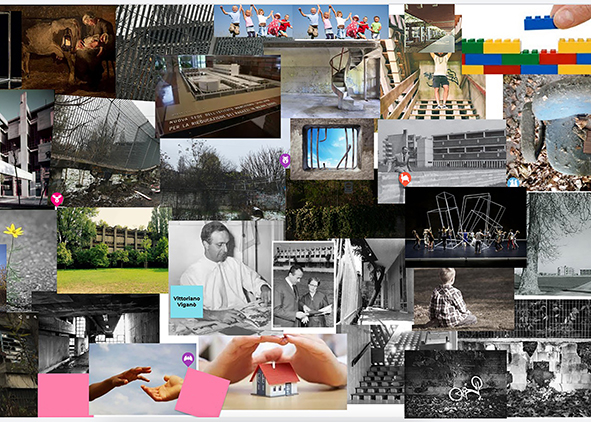Education and memory. Pedagogy of remembrance and communication design
DOI:
https://doi.org/10.19229/2464-9309/10242021Keywords:
identity, memory of places, communication design, atmosphere, educationAbstract
Memory is rooted into places, and it can be an elective design tool to communicate the evolution of landscapes and to teach the value of memory. The Institute of Higher Education G. Galilei-R. Luxemburg in Milan interpreted the MIUR call for applications ‘Cinema per la scuola – I progetti delle e per le scuole’, proposing memory topics and creating a documentary about the Institute Marchiondi ‘for problematic children’. Communication Design reveals, with educational effectiveness, what lies behind the obsolescent atmosphere of the brutalist ruins of architecture and starts what can be called a ‘pedagogy of remembrance’. The research results in the analysis of the connections between virtual, physical and digital forms of memory, in an interpretative framework that opens to an educational context.
Downloads
Article Metrics Graph
References
Agazzi E. and Fortunati V. (eds) (2007), Memoria e saperi – Percorsi transdisciplinari, Booklet, Milano.
Augé, M. (2004), Rovine e macerie – Il senso del tempo, Bollati Boringhieri, Torino.
Baule, G., Calabi, D. A. and Scuri, S. (2014), “Narrare il Territorio – Dispositivi e Strategie d’Innovazione per gli Spazi Percepiti”, in Coletta, C., Colombo, S., Magaudda, P., Mattozzi, A., Parolin, L. L. and Rampino, L. (eds), A Matter of Design – Making Society trough Science and Technology – Proceedings of the 5th STS Italia Conference, STS Italia Publishing, pp. 1-15. [Online] Available at: academia.edu/15514760/Narrare_il_Territorio_Dispositivi_e_Strategie_ dInnovazione_per_gli_Spazi_Percepiti [Accessed 15 September 2021].
Böhme, G. (2010), Atmosfere, estasi, messe in scena – L’estetica come teoria generale della percezione, Marinotti, Milano.
Broccardi, F. and Vicari C. (2019), “Social network economy – Musei, follower e partecipazione”, in Artribune.com, newspaper online, 12/04/2019. [Online] Available at: artribune.com/progettazione/new-media/2019/02/social-network-economy-musei-follower-partecipazione [Accessed 15 September 2021].
Burns, P., Palmer, C. and Lester, J. (eds) (2010), Tourism and Visual Culture – Volume 1 Theories and Concepts, CABI, Wallingford (UK).
Calabi, D. A. (2009), “Design della comunicazione e territorio – Uno strumento strategico di relazione | Communication design and environmental – A strategic instrument of relationship”, in Strategic Design Research Journal, vol. 2, issue 1, pp. 7-10. [Online] Available at: revistas.unisinos.br/index.php/sdrj/article/view/5148 [Accessed 15 September 2021].
Careri, F. (2006), Walkscapes – Camminare come pratica estetica, Einaudi, Torino.
Cattunar, A. (2014), “Memorie di confine – L’archivio multimediale e il museo diffuso dell’Associazione Quarantasettezeroquattro”, in Storia e Futuro – Memorie del quotidiano, n. 34, pp. 1-20. [Online] Available at: storiaefuturo.eu/memorie-di-confine-larchivio-multimediale-e-il-museo-diffuso-dellassociazione-quarantasettezeroquattro [Accessed 15 September 2021].
Cometa M. and Coglitore R. (eds) (2016), Fototesti – Letteratura e cultura visuale, Quodlibet, Macerata.
Fabris, A. (2018), Etica per le tecnologie dell'informazione e della comunicazione, Carocci, Bologna.
Fiorani, E. (2005), I panorami del contemporaneo, Lupetti, Milano.
Foucault, M. (2004), Utopie Eterotopie, Cronopio, Napoli.
Fratelli, M. and Sacerdoti, P. (eds) (2015), Milano Città Immaginata – 10 progetti dagli archivi CASVA, Comune di Milano, Milano.
Galasso, C. (2018), Zone di memoria – Il design per gli archivi del territorio, FrancoAngeli, Milano.
Graf, F. and Tedeschi, L. (eds) (2009), L’Istituto Marchiondi Spagliardi di Vittoriano Viganò, Mendrisio Academy Press, Mendrisio.
Greer, J. and Grobman, L. (eds) (2017), Pedagogies of Public Memory – Teaching Writing and Rhetoric at Museums, Memorials, and Archives, Routledge, London.
Griffero, T. (2016), Il pensiero dei sensi – Atmosfere ed estetica patica, Guerini e Associati, Milano.
Griffero, T. (2009), “Atmosfericità – ‘Prima impressione’ e spazi emozionali”, in Aisthesis, vol. 2, issue 1, pp. 49-66. [Online] Available at: doi.org/10.13128/Aisthesis-10947 [Accessed 15 September 2021].
Irace, F. (2013), Design & Cultural Heritage – Immateriale Virtuale Interattivo | Intangible Virtual Interactive, Electa, Milano.
Karp, I. and Lavine, S. D. (eds) (1995), Culture in mostra – Poetiche e politiche dell’allestimento museale, CLUEB, Bologna.
Lupo, E. and Trocchianesi, R. (2013), Design & Cultural Heritage – 3. Progetto e Memoria del temporaneo | Design and Memory of the Ephemeral, Electa, Milano.
Marrone, G. (2001), Corpi sociali – Processi comunicativi e semiotica del testo, Einaudi, Torino.
Quaggiotto, M. (2012), Cartografie del sapere – Interfacce per l’accesso agli spazi della conoscenza, FrancoAngeli, Milano
Ricoeur, P. (2004), Ricordare, dimenticare, perdonare – L’enigma del passato, Il Mulino, Bologna.
Viganò, V. (1958), “L’Istituto Marchiondi a Milano-Baggio – L’internato per ragazzi difficili di Vittoriano Viganò”, in Comunità, n. 57, pp. 64-70.
Vitale, G. (2013), Design di sistema per le istituzioni culturali – Il museo empatico, Zanichelli, Bologna.

Downloads
Published
How to Cite
Issue
Section
License
This Journal is published under Creative Commons Attribution Licence 4.0 (CC-BY).
License scheme | Legal code
This License allows anyone to:
Share: copy and redistribute the material in any medium or format.
Adapt: remix, transform, and build upon the material for any purpose, even commercially.
Under the following terms
Attribution: Users must give appropriate credit, provide a link to the license, and indicate if changes were made; users may do so in any reasonable manner, but not in any way that suggests the licensor endorses them or their use.
No additional restrictions: Users may not apply legal terms or technological measures that legally restrict others from doing anything the license permits.
Notices
Users do not have to comply with the license for elements of the material in the public domain or where your use is permitted by an applicable exception or limitation.
No warranties are given. The license may not give users all of the permissions necessary for their intended use. For example, other rights such as publicity, privacy, or moral rights may limit how you use the material.


















































































